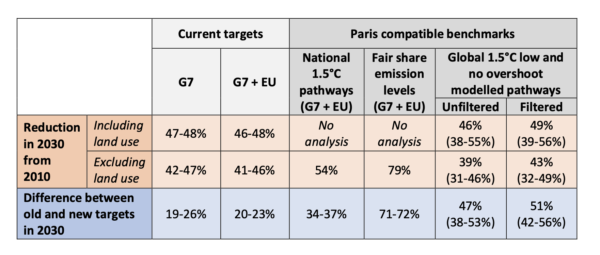Are the G7 pulling their weight on climate?
Authors
Claire Fyson, Matthew Gidden, Andreas Geiges, Marie-Camille Attard
Share

This weekend the members of the G7 will meet in the UK, in a year that marks an important deadline for countries to bring forward stronger climate targets.
All of the G7 governments, covering roughly half of global GDP and over a fifth of greenhouse gas emissions, have enhanced their targets in the last year. But are these countries and other major economies pulling their weight?
As of April 2021, the Climate Action Tracker estimates that recently announced updates to national climate targets, or Nationally Determined Contributions (NDCs), takes end of century temperature rise down from ~3°C to 2.4°C if acted upon.
But a substantial emissions gap remains between where we’re heading in 2030, and where we need to be to limit warming to 1.5°C. More work still needs to be done.
Global targets, national action
To assess the G7+EU’s progress, we looked at governments’ 2030 climate targets and compared them with the global emissions reductions required according to emissions pathways consistent with the Paris Agreement’s long-term temperature goal. We then filtered out pathways that rely on very large amounts of carbon dioxide removal by mid-century that go beyond global sustainability limits. Pathways that pass this filter tend to have faster emissions reductions in the near to medium-term.
In our filtered set of scenarios, we find global greenhouse gas emissions need to reduce by 49% from 2010 levels by 2030 (including land use emissions), or by 43% excluding land use. This is compared to the 46% and 39% with and without land use emissions from the unfiltered scenarios used in the IPCC’s Special Report: Global Warming of 1.5°C.
Compared with 2010 levels, the G7 countries are close to meeting the global benchmark from our filtered pathways (excluding land use), with targets collectively achieving an estimated 42-47% reduction by 2030. If the EU is added, this falls slightly to 41% by 2030.
When land use emissions are included, the G7 and EU come up just short of the filtered pathways, but are ahead of the unfiltered global benchmark of around 45%.
This means that the G7 and EU current targets still implicitly rely on very large amounts of carbon dioxide removals to meet the 1.5°C limit. These removal technologies are currently untested at large-scale, are costly, and come with their own questions surrounding sustainability – therefore our reliance on them should be minimised as far as possible.
National 1.5°C pathways and targets
Climate Analytics has undertaken new analysis, launching at the end of this month, that looks at countries’ national pathways to 1.5˚C in context with their current targets and policies to see where they should be accelerating actions to decarbonise.
Global pathways don’t tell us at what pace emissions reductions are feasible in different countries and regions. So we downscaled our filtered set of pathways to the national level. These national 1.5°C pathways show what could be expected of individual countries if global mitigation costs are minimised.
When we do this, we see G7 and EU governments must actually go beyond the numbers in the global pathways above, to achieve a reduction of 54%. This is because these countries can decarbonise earlier, having already reduced their emissions substantially, and need to do so in order to make up for those developing countries who will need longer.
Comparing current targets to our national 1.5°C pathways, the G7 and EU are collectively getting closer to the mark, but still fall 8-13% short of the 54% reduction needed from 2010 levels. Of the big emitters, only the UK has set a target that we assess to be consistent with a national 1.5°C consistent pathway.
Looking at where emissions are heading under currently implemented policies, the G7 have much further to go: in 2030, emissions from G7 and EU countries are projected to be only 13-21% lower than 2010 levels. That’s less than half the reduction in our national 1.5°C pathway.
A critical priority for G7 and EU governments is the decarbonisation of electricity generation: coal needs to be phased out by 2030, renewables deployment needs to be accelerated and, as a recent IEA analysis made clear, there is no space for new gas infrastructure in this transition.

2030 emission reductions under: 1) G7 and G7+EU updated targets, 2) G7 + EU national 1.5°C pathways, 3) G7 + EU fair share emissions levels from the Climate Action Tracker, and 4) global 1.5°C pathways, shown as a reduction from 2010 levels (orange) and a reduction from the 2030 emissions consistent with targets submitted in 2015/2016 (blue).
What 2030 climate targets should have looked like
Globally, NDCs should have been strengthened from those submitted in 2015 by around 50%. This means that the emissions projected in 2030 under the updated NDCs should be half of the level projected under the old set of targets.
The G7 and EU collectively fall short of this benchmark by a long way, having strengthened their targets by a moderate 20-23%. Among the G7’s members, the laggards are France, which has yet to submit an updated target, and Canada, which strengthened its target the least – under Canada’s new target, emissions in 2030 are only 12-19% lower than under its previous NDC.
To pull their weight, the G7 and EU would have had to strengthen their targets substantially, by more than a third (34-37%). Our previous analyses have shown that the US, EU Japan, could have increased their targets to: up to 63% below 2005, 70% below 1990, and 62% below 2013, respectively.
But what would be a fair target?
It’s important to remember that these pathways are designed to show routes to limiting warming in a way that minimises costs at the global level, without considering fairness.
Under the Paris Agreement, collective efforts to limit warming to 1.5°C must take equity into account. This means that wealthier countries and those with greater historical responsibility should take the lead in reducing their emissions as quickly as possible, and also provide support for mitigation activities in countries with more limited capacities.
For G7 governments to make a fair contribution to reducing emissions they would need to achieve a roughly three quarters reduction in emissions from 2010 levels. Such a stringent reduction is not likely to be achieved domestically, and therefore this gap would need to be filled with a significant increase in the provision of climate finance to developing countries.
Developed countries are already falling short of the USD 100 billion climate finance goal agreed in Paris to be delivered by 2020. G7 ministers recently committed to increase their climate finance contributions, and some G7 members have brought forward improved finance pledges. But with a clear shortfall in both emissions reductions and climate finance, much more needs to be done.
Which major economies have made the biggest changes?
Some governments have strengthened their NDCs by more than the G7 average: the EU, Japan and the UK, as well as other Paris signatories such as South Africa, Chile, Argentina and Norway, all reduced their 2030 emissions targets by about a quarter below their previous targets.
The US has strengthened its ambition significantly (~40%) from where policies under the previous administration were heading. But when compared with a projection to 2030 under the Obama administration target, the change is more moderate (approximately 20%).
These updates are a significant step in the right direction, but still not the level of transformational change required to keep warming to 1.5°C.
How is this impacting warming?
With many major emitters having submitted an updated NDC, more are expected in the lead up to COP26 in November. A key question is whether these will be enough to put us on track for the Paris Agreement’s 1.5°C limit?
To help answer this question we developed the NDC ambition explorer, where users can adjust the level of ambition of national targets to see what impact this could have on warming levels. For example, if all countries were to strengthen their targets by 50% from what they were in 2015, end-century warming would be below 1.5°C.
The G7 and other major emitters should lead by example, strengthen their targets to be 1.5°C compatible, and ramp up their climate finance to help other countries achieve their potential. Around 100 countries have still not submitted an update, so the race is on to keep the 1.5°C warming limit within reach.
Our new webtool, the 1.5°C Pathway Explorer, which looks at national trajectories towards the long-term temperature goal of the Paris Agreement, will be launched at the end of this month.











